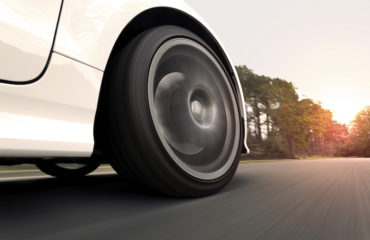Along with spring’s longer days and warmer weather come new challenges for drivers on the road. From decreased visibility to slick streets to more pedestrians, spring brings its own unique risk factors that require extra attention behind the wheel. To stay safe and protect yourself and your passengers while driving in springtime, be sure to exercise proper care and caution.

Harsh rains can compromise visibility fast when you don’t have wipers to keep your view cleared.
Seven Tips for Safety
How can you practice safe and defensive driving this season? Here’s a look at some of the top spring driving safety tips to keep in mind:
- Turn on Your Lights. Your car’s lights are for more than night driving. Whether it’s a rainy day or a foggy morning, any time your visibility is hindered, turn on your lights. Take the time now to make sure all your lights are in working order, from the headlights to taillights to turn signals. If anything’s busted, get it fixed now to be prepared for the season ahead.
- Check Your Wiper Blades. The last thing you want this season is to get stuck in a storm with busted wiper blades. Harsh rains can compromise visibility fast when you don’t have wipers to keep your view cleared. Take the time now, even before the rainy season strikes, to make sure they’re working properly and will be ready to clear your windshield in months to come.
- Check Your Tires. Winter can wreak havoc on a car’s tires, which is exactly why now is the time to get them checked. Are the treads worn? If so, they can make you lose traction. Are they properly inflated? If the pressure is too high, you can lose traction and stopping distance; if it’s too low, your tires could overheat and even lead to a serious accident. Full, properly inflated tires can reduce risks from potholes and other hazards, providing extra protection on the road.
- Change Your Cabin Air Filter. This one’s more about comfort than dangers on the road, but since spring is notorious for seasonal allergies, take preventative measures now to keep your air pollutant-free. Change the cabin air filter to make sure it’s working at its best to minimize exposure to dust and pollen.
- Slow Down. Whether you’re in a residential neighborhood or a city’s downtown, if there is a chance pedestrians are present, slow down. While you can’t control whether or not a toddler runs into the street, you can be prepared to make fast decisions that could prevent serious accidents. One key is lowering your speed. Likewise, stay alert to pedestrians, cyclists, runners and other people who may be on the road.
- Stay in the Middle. If you’re caught on the roads when a heavy rainfall or storm hits, remember that wet roads can be just as dangerous as snowy or icy ones. In addition to turning on your lights and slowing down, try to stick to the middle lanes, where there will likely be less flooding.
-

Whenever possible, try to go around and avoid deep potholes
Avoid Potholes. The wear and tear of winter typically leaves potholes in the roads, so, come spring, there are large potholes all over. Whenever possible, try to go around and avoid deep potholes; they can throw your car out of alignment, leading to problems on the road as well as potentially the need for a new wheel and a new tire.
Like it or not, spring brings more than showers, especially for drivers — so always stay alert when driving! Use the above tips to ensure you’re prepared for any spring driving challenges that come your way.
Author Bio
Kimberly Quinones is the Vice President of Sales in the Midwest where she oversees all aspects of sales, service and customer retention programs for Access Insurance. Kimberly is a proactive leader who works alongside her teams and customers to ensure a strong relationship is built.





